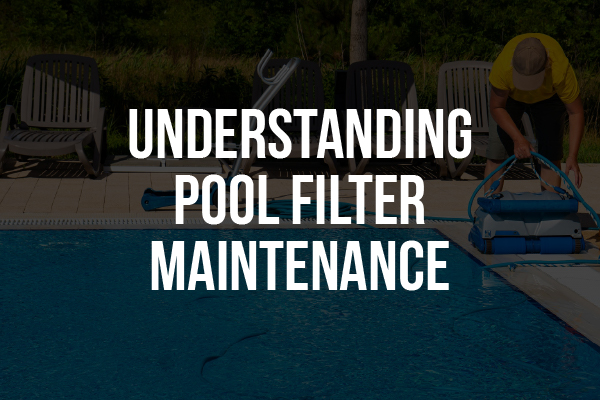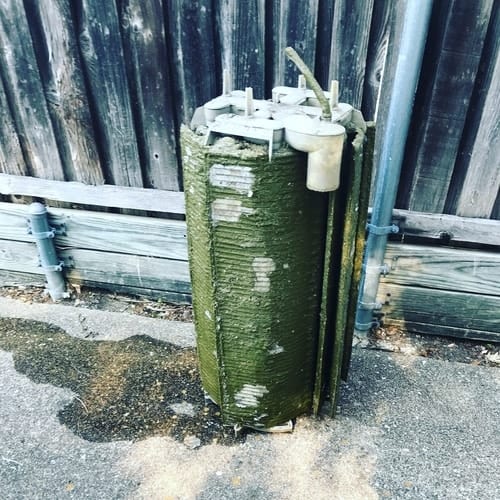
A swimming pool is a great place to unwind after a long day. There are few things as refreshing as being in a swimming pool on a hot summer day unless, of course, the swimming pool is dirty. A dirty swimming pool isn’t just unattractive and gross; it can also be a breeding ground for disease. Your pool filter is a vital part of keeping your swimming pool clean, and it requires regular maintenance to function efficiently. In this blog post, Liquidus Pool Services will explain how to maintain your pool’s filter so it can work properly.
Pool Maintenance Requirements
Pool maintenance is a vital part of pool ownership. It can be time-consuming and at times difficult; but, companies like ours that specialize in pool cleaning can help take the load off your shoulders.
A swimming pool consists of four primary elements that require maintenance. These include the following:
1. Pool Water
By keeping your pool water clean, you are protecting the health of those using your pool, maintaining the pool’s appearance, and preventing damage to other parts of the pool.
2. Pool Interior
Another important element to maintain is the pool liner. As it is constantly in contact with water and everything else in your pool, it can have a big impact on the condition of your pool. Proper maintenance can keep it in good condition and clear of algae, mold, and debris.
3. Pool Water Filtration System
A pool filter keeps your water clean. There are three types of filters: sand filters, cartridge filters, and D.E. (diatomaceous earth) filters.
4. Pool Skimmers and Returns
A skimmer draws in water to the pool filter while the return pushes newly cleaned water back into the pool. Please note that this skimmer is different from a net skimmer. A net skimmer is a hand-held tool.
Types of Swimming Pool Filters

There are three types of pool filters on the market. Each of them has their own characteristics and maintenance requirements.
Sand Filters
A sand filter is essentially a filtration tank filled with sand. A sand filter works by having a pool pump push water past the sand, causing the sand to “catch” debris and contaminants. Over time, the sand particles wear down, reducing their effectiveness. A sand filter generally catches particles 20 microns in diameter and larger (depending on the type of sand).
Sand Filter Benefits:
- Easy to maintain
- The sand typically lasts five to seven years before it needs to be changed out
- By using alternative media and additives, you can increase filtration efficiency
Sand Filter Negatives:
- When pressure builds up, filter efficiency decreases
- Least effective at filtration of the three types of filters
- When backwashing and rinsing, water is typically wasted
Cartridge Pool Filters
A cartridge filter consists of a plastic tank that contains 1 – 4 cartridges. Each cartridge is a plastic cylinder surrounded by pleated polyester filter media with caps on the ends. Cartridge filters are energy efficient. They can filter out contaminants that are as small as 10 microns in diameter.
Cartridge Pool Filter Benefits:
- No backwashing, which saves water
- Does well with low water speeds such as with variable speed pumps
Cartridge Pool Filter Negatives:
- A cartridge pool filter requires more work than a sand filter
- Cartridges typically last two to three years
- Requires deep cleaning 2 – 3 times each year
Diatomaceous Earth Pool Filters (D.E. Filters)
A D.E. Filter uses grids coated in white D.E. powder to clean the water. Like a Sand Filter, D.E. Filters are equipped with a backwash valve that allows for quick “backwash” cleanings to help water circulate more easily. This type of filter requires the most maintenance of all filter types but is also the most effective. D.E. filters can filter out debris as small as 5 microns in diameter.
If D.E. is not properly disposed of however, it can harm wildlife and block storm drains. Some areas have specific laws or regulations on how to dispose of D.E.
Caution: Be sure to wear a chemical mask and eye protection when handling D.E. powder, as inhaling the powder can be extremely hazardous to your health. Keep all D.E. out of reach of children and animals. If you don’t know how to handle D.E., please contact a pool professional.
D.E. Filter Benefits:
- Filters contaminants as small as 5 microns in diameter.
- You can add D.E. powder via the pool skimmer
- No caustic chemicals required
DE Filter Negatives:
- Inhaling D.E. powder is hazardous
- Requires deep cleaning 3 – 4 times each year
- Grids typically need replacing every 2 – 3 years
- Above-ground pool D.E. filters are hard to find
- Local rules may restrict backwashing
Pool Filter Maintenance

Pool filter maintenance helps keep your pool attractive, clean, and safe. As pool filters do their job, contaminants build up inside them, reducing their effectiveness. As a result, pool filters need to be periodically cleaned and replaced.
How Often Should a Pool Filter Be Cleaned?
A pool filter generally needs to be cleaned every 3 months, if not more often.
The frequency often depends on your type of pool filter in relation to the size of your pool.
Several signs may indicate your filter needs cleaning. These can include:
- Cloudy pool water
- A pressure gauge that reads ten PSI (pounds per square inch) over the normal level
How to Clean the Different Types of Pool Filters
Different pool filters have their own cleaning procedures. It is important to follow the manufacturer’s instructions or hire a professional if you don’t wish to do it yourself.
In the following section, we detail how to clean the three types of pool filters.
How to Clean Sand Filters
When a sand filter gets to over ten PSI the normal operating level, it will need to be backwashed. If you observe cloudy pool water, it may be time to clean your filter.
At least once per year, a sand filter must be chemically cleaned.
1. Backwash your Sand Filter
Firstly, you’ll need to shut off the pump. Then, turn the multiport valve handle to “Backwash.” Hook up the backwash hose to the waste port and start the pump up again. Then backwash about one to two minutes or until the water runs clear.
2. Add in a Filter Cleaning Solution
Shut off the pump again and turn the valve to “Filter.” Next, take off the pump’s strainer lid and put the sand filter cleaner into the strainer basket. Then, put the strainer lid back on.
Turn on and run the pump for roughly 15 seconds—just enough time for the cleaner to move from the pump over to the filter. Shut off the pump for at least eight hours or overnight.
3. Backwash the Filter Again
Once the filter has soaked for at least 8 hours, backwash the filter for a period of three to five minutes to remove any built-up debris and dirt that the filter cleaner has dislodged. Start the filter system back up.
How to Clean Cartridge Filters
Once a week, you typically need to rinse the cartridge filter or filters with water.
About once a month, you’ll need to spray off the cartridge filter or filters with a filter cleaner. After you’ve done that, allow the filter or filters to sit for 15 minutes, then rinse off the filter(s) with fresh water.
Every six months to one year, you need to soak the cartridge filter or filters for 24 hours in a dilated filter cleaner. Next, rinse off the filter with clean water.
Cleaning Your Cartridge Filter
Depending on how dirty the filter cartridge is, you may need to clean it overnight.
1. Shut Off the Pump and Depressurize the Filter Tank
The first step is to shut off your pump. Please be advised that if the pump has a timer, you’ll need to remove anything that might trigger the timer and turn the pump back on.
For safety, you’ll also need to remove the air from the system. Do this by slowly turning the air relief valve to release any leftover air from the system. This valve is often located at the top of the filter.
2. Take the Cartridge Out of the Filter Tank
Please note: If you don’t know how to do this, be sure to consult the owner’s manual or reach out to a swimming pool professional.
Take off the filter tank clamps (or corresponding latch mechanism) holding the filter together.
Take off the top of the filter. Then, gently remove the filter and place it out of the way.
Check the filter for wear or damage. If you detect tears, cracks, or notice that cleaning it will not be effective, you may need to replace the filter.
3. Clean the Filter Cartridge
To clean the filter cartridge, spray it with a hose, taking care to get between pleats. If the filter cartridge is dirty, you can use a filter cartridge cleaner.
If the filter cartridge hasn’t been cleaned in a while, it may have accumulated calcium build-up, algae, iron, sunscreen, and other impurities. When extra cleaning is needed, soak the filter cartridge overnight in a filter cleaning solution. To do this, use a five-gallon bucket to ensure that the filter cartridge is completely submerged in the water and cleaning solution.
Inspect your filter tank’s O-ring. If the O-ring is in good condition, gently apply lubricant to help keep it in good condition. If the O-ring is dry-rotted or looks worn, you may need to replace it.
Be sure to thoroughly rinse the filter cartridge using water before you place it back into the tank.
4. Reinsert the Filter Cartridge, then Repressureize
Place the cartridge back into the filter and make sure it is securely in position. Put the filter top back on and ensure the clamps are correctly tightened.
Reactivate the system, and open up the air release valve so any excess air in the system gets released. Keep the valve open until a steady stream of water sprays out.
Inspect your pressure gauge to make sure it indicates it is in the regular filter pressure range. If the PSI is not right, this can be a sign that the filter was reassembled incorrectly or there is another problem with the system. In this case, you may need to troubleshoot the system to locate and fix the problem.
How to Clean D.E. Filters
A D.E. filter should be cleaned monthly or earlier if you detect that it is dirty. A D.E. filter can be backwashed or chemically cleaned. If you don’t know how to clean a D.E. filter, please have the services done by a reputable pool professional.
Caution: Be sure to wear a chemical mask and eye protection when handling D.E. powder as it is extremely hazardous to your health. Keep it out of reach of children and animals.
1. Backwash and Drain the D.E. Filter
Start by shutting off the pump and then positioning the multiport valve to “Backwash.” Please note that if your valve is the push/pull type, you’ll need to ensure that it is set to the “Backwash” position.
Secure the backwash hose to the waste port and start the pump back up. Backwash for one to two minutes or until the water runs clear.
Then, shut off the pump and open up the air release valve. Finally, take out the drain plug and allow the water to drain from the filter tank.
2. Take Out the D.E. Filter Manifold
Take off the clamps (or other latch device), keeping the filter together. If you don’t know how to open it, please consult the owner’s manual or reach out to a professional.
Open up the filter tank and remove the filter manifold; also, take out all the fingers or grids.
3. Rinse and/or Soak the Filter Grids or Fingers
Spray the manifold and fingers/grids with a garden hose spray nozzle, being sure to flush out any debris thoroughly, including D.E. powder. If your manifold is exceptionally dirty, apply a D.E. filter cleaner. Be sure to follow the package instructions.
4. Reassemble the Pool Filter
When you have cleaned the filter manifold, rinse out the tank with the garden hose. Place the filter manifold back into the filter tank.
Reattach the clamps (or other latching device) holding the filter together. If you don’t know how to close it, please consult the owner’s manual.
5. Add New D.E. Powder
Check your filter’s manual to determine the amount of D.E. powder needed. Then, mix that amount with enough water to make a creamy and thin solution known as a slurry.
Ensure that the pump is running, and pour the slurry you just made into the pool skimmer. After doing that, have the pool pump run for at least thirty minutes so the D.E. can distribute on the fingers or grids of the filter.
FAQs
Pool filter backwashing is when you reverse the flow of water through your pool filter, freeing clogged debris. Different pool filters may have different backwash procedures to follow.
Various signs may indicate that it is time to replace your pool filter. Please note that this list is not necessarily conclusive.
Filter Age: There are different limits to how long a filter can last. This can vary by filter type and make. Take note of your filter’s use-by date and do not exceed it.
Damage to the Filter: When cleaning your pool filter, be sure to inspect it for signs of damage, such as tears in the fabric or damage to the plastic end cap. If your filter has damage, it will need to be replaced, as damage can reduce its ability to help keep your pool clean.
Water is in Poor Condition: If your pool water is dirty despite having the right chemical balance, it could be a sign that your pool filter needs to be replaced. Other signs to look for include requiring more sanitizer than normal or needing to run the filter longer to keep your water clean.
Liquidus Dallas Pool Maintenance Services – Take Your Weekend Back

While pools can be a lot of fun, they also take a great deal of work. It can be hard to find time to fit necessary pool upkeep into an already busy schedule. If you’re in the Dallas Fort Worth Metroplex, Liquidus Pool Services can help. Since 2017, we’ve been helping people take their weekends back. We offer a range of services to help keep your pool in excellent condition: pool cleaning, algae removal, maintenance, and repair. If you’re in the market for a new pool, we also offer pool installation.
